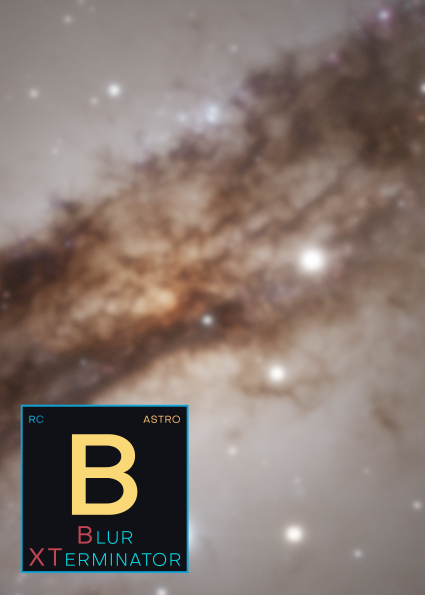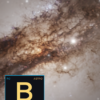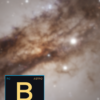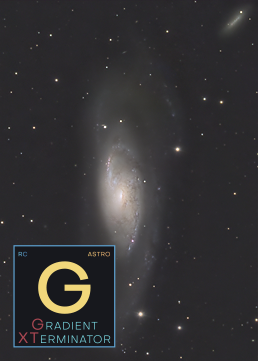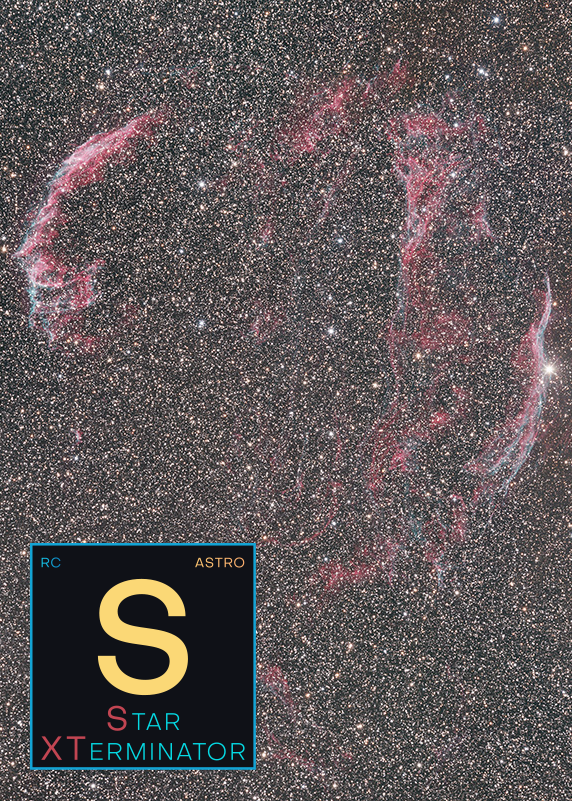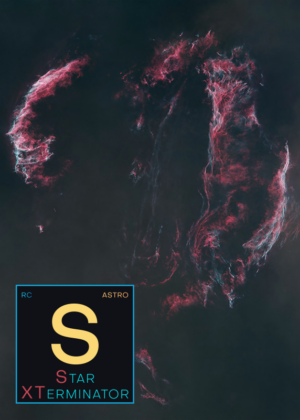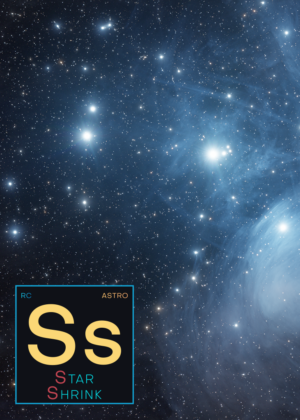✅ PixInsight
❌ Photoshop
❌ Affinity Photo
BlurXTerminator is an AI-powered deconvolution tool designed specifically for astronomical images. It is available as a plug-in process module for PixInsight only. Because deconvolution inherently requires linear image data, BlurXTerminator will not be made available for general photography applications such as Photoshop.
Not all AI is created equal. AI-based sharpening tools for general photography exist, but they were not trained with astronomical images in mind. They don’t usually handle stars very well, and because they are trained as generative AI models, they have no regard for veracity and often invent detail that does not exist.
The design intent of BlurXTerminator is to recover as much detail as possible based on low-contrast information actually present in an image, without fabricating detail that does not in fact exist just for the sake of an image that appears sharper. Great care has been taken in the architecture and training of the neural network to ensure that its output is as faithful as possible to reality if it is properly used.
All deconvolution, including the classical algorithms developed by Richardson, Lucy, van Cittert, and others, fundamentally involves guesswork. Mathematically, deconvolution is said to be an ill posed problem: for a given blurry input image, there are many possible sharper images that, if re-blurred, would result in the same input image. Which one is correct, or at least a better guess?
All deconvolution algorithms use knowledge of an image’s point spread function (PSF). BlurXTerminator automatically determines the PSF in astronomical images using the stars present in the image: each star is a copy of the PSF.
BlurXTerminator’s training additionally includes a deep understanding of the common optical aberrations that astronomical images are subject to, including those caused by atmospheric turbulence, scattering, acquisition issues such as guiding errors, and optical distortions such as coma and chromatic aberration. There is no need to extract the PSF ahead of time: BlurXTerminator analyzes and processes images in one step, with no iteration required in most cases.
BlurXTerminator can apply different amounts of deconvolution to the stellar and nonstellar features of an image. Trying to recover all of the detail available in nonstellar, extended objects using the classical algorithms usually results in dark halos (ringing) around stars. With BlurXTerminator, more sharpening can be applied to the nonstellar parts of an image, bringing out more detail without producing ringing artifacts in most cases.
BlurXTerminator can additionally correct for other aberrations present in an image in limited amounts. Among those currently comprehended for most instruments are:
- First- and second-order coma and astigmatism
- Trefoil (common with pinched optics and in image corners with some camera lenses)
- Defocus (poor focus and/or field curvature)
- Longitudinal and lateral chromatic aberration
- Motion blur (guiding errors)
- Seeing/scatter variation per color channel
- Drizzle upsampling artifacts (2x only)
These aberrations are not assumed to be stationary: they can vary across the field of view. This is a major advantage over most implementations of the classical deconvolution algorithms, which assume that the same PSF applies to the entire image. For example, stars with limited comatic profiles in the corners of an image will be made round and then sharpened, while stars in the center that are already round will simply be sharpened. This correction can be applied to the nonstellar features in an image, too. Correction can be done as a separate step, or in combination with sharpening.
System Requirements
BlurXTerminator is available only as a plug-in process module for PixInsight. Because deconvolution inherently requires linear image data, BlurXTerminator will not be made available for general photography applications such as Photoshop.
BlurXTerminator requires a computer with a modern CPU having “AVX” instructions required to run neural networks. Older CPUs, and even some modern stripped-down CPUs in mini-PCs and lightweight laptops lack AVX instructions and are not supported. Request a trial before purchasing to make sure BlurXTerminator will work on your machine.
Neural network computations can benefit greatly from GPU acceleration. On Macs, GPU acceleration of BlurXTerminator is automatic, leveraging the “CoreML” software library provided by Apple. Performance is particularly fast on recent Apple silicon based Macs (M1, M2, etc.) due to their extremely performant built-in GPU and neural engine hardware.
On Windows and Linux machines, GPU acceleration takes a bit more effort.
Additional requirements
- PixInsight 1.8.9-3 or later, or
- Photoshop CC or later, or
- Affinity Photo 2.0 or later
- MacOS 12 (Monterey) or later
- External GPUs are not supported
- Windows 10 (22H2) or later
- Modern Intel/AMD x64 CPU capable of running neural networks (AVX, AVX2, and SSE instruction support required)
- Linux (PixInsight only)
- Ubuntu 18.04 or later, or equivalent (glibc 2.27 or later required)
- Modern Intel/AMD x64 CPU capable of running neural networks (AVX, AVX2, and SSE instruction support required)
Revision History
PixInsight Module |
||
|---|---|---|
| Version | Date | Comments |
| 2.1.4 | 14 Apr 2025 |
MacOS only: works around a crash in PixInsight’s ImageStatistics functions that affected some machines
|
| 2.0.4 | 18 Dec 2024 |
Updated to work with PixInsight 1.9.0
|
| 2.0.0 | 14 Dec 2023 |
Updated to work with AI4.
|
| 1.2.1 | 2 Sep 2023 |
Fixed a bug that caused non-stellar features in real-time previews to be overprocessed when zoomed out and using manual PSF diameter.
|
| 1.2.0 | 27 Aug 2023 | Corrected a bug in the luminance-only mode that caused a grid of over-saturated pixels between processing tiles.
Corrects an issue that could cause over-darkening of shadow regions in certain images. More intelligent validation/selection of AI definition files.
|
| 1.1.18 | 5 Aug 2023 |
Corrects an issue that could cause over-darkening of shadow regions in certain images. Releases CPU/GPU memory consumed by the neural network after processing an image (note that the TensorFlow framework may still keep GPU memory allocated, but it will be available for other AI-powered processes).
|
| 1.1.17 | 24 Jul 2023 | Corrected an issue that caused the real-time preview to stop updating for monochrome images. |
| 1.1.16 | 20 Jul 2023 | Corrected minor clipping in shadow regions. Improved preservation of background levels. New tiling algorithm to better handle the edges of images. |
| 1.1.2 | 21 Jan 2023 | MacOS only: corrected the selection of the appropriate AI file format (mlmodel vs. mlpackage) on certain MacOS 10.15 (Catalina) versions. |
| 1.1.1 | 10 Jan 2023 | Added luminance-only mode, improved consistency of aberration correction near the edges and corners of images, and enabled 32-bit floating point precision for MacOS 12 and later, improving accuracy and eliminating posterization in bright areas. |
| 1.0.2 | 14 Dec 2022 | Initial broad release. Minor user interface refinement and documentation updates. |
| 1.0.1 | 12 Dec 2022 | Correctly finds the latest installed AI version by default. |
| 1.0.0 | 8 Dec 2022 | Initial beta release |
AI Definition |
||
| Version | Date | Comments |
|---|---|---|
| 4 | 14 Dec 2023 | Expanded optical aberration correction. Direct linear image processing improves flux conservation and general accuracy. |
| 3 beta 2 | 6 Aug 2023 | Experimental release increasing the range of optical aberrations handled. |
| 2 | 10 Jan 2023 | Improved preservation of star colors as well as general accuracy of deconvolution. |
| 1 | 8 Dec 2022 | Initial release |

